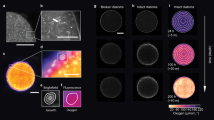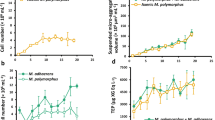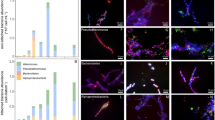Abstract
LARGE, rapidly sinking organic aggregates are an important component of the carbon flux from the ocean's surface to its depths. Marine snow, the main type of large (<0.5 mm) aggregate, is heavily colonized by bacteria in surface waters1, yet the carbon demand of the attached bacteria is so small that months to years are required to consume the aggregates' carbon2–5. This has led to the conclusion that marine aggregates are resistant to degradation by attached bacteria, and thus act as refractory carriers of carbon to the deep ocean. Here we report that aggregates play host to intense activities of hydrolytic enzymes (presumably due to cell surface bound and released enzymes of the attached bacteria), which render the aggregates soluble. Particulate amino acids were hydrolysed rapidly (turnover time 0.2–2.1 days), with very little of the hydrolysate being taken up by the attached bacteria. Our results support the hypothesis6,7 that such 'uncoupled' hydrolysis is a biochemical mechanism for large-scale transfer of organic matter from sinking particles to the dissolved phase, and may supply the slowly degradable dissolved organic matter for downward export postulated by recent models8–10.
This is a preview of subscription content, access via your institution
Access options
Subscribe to this journal
Receive 51 print issues and online access
$199.00 per year
only $3.90 per issue
Buy this article
- Purchase on SpringerLink
- Instant access to full article PDF
Prices may be subject to local taxes which are calculated during checkout
Similar content being viewed by others
References
Alldredge, A. L. & Gotschalk, C. C. Cont. Shelf Res. 10, 41–58 (1990).
Ducklow, H. W., Kirchman, D. L. & Rowe, G. T. Appl. envir. Microbiol. 43, 769–776 (1982).
Alldredge, A. & Youngbluth, M. Deep Sea Res. 32, 1445–1456 (1985).
Karl, D. M., Knauer, G. A. & Martin, J. H. Nature 332, 438–441 (1988).
Simon, M., Alldredge, A. L. & Azam, F. Mar. Ecol. Prog. Ser. 65, 205–211 (1990).
Azam, F. The Radioecological Role of Marine Bacterioplankton 1–2–7 (Institut Royal des Sciences Naturelles de Belgique, Brussels, 1984).
Cho, B. C. & Azam, F. Nature 332, 441–443 (1988).
Sarmiento, J. L., Toggweiler, J. R. & Najjar, R. Phil. Trans. R. Soc. Lond. 325, 3–21 (1988).
Bacastow, R. & Maier-Reimer, E. Global biogeochem. Cycles 5, 71–85 (1991).
Najjar, R. G., Sarmiento, J. L. & Toggweiler, J. R. Global biogeochem. Cycles 6, 45–76 (1992).
Honjo, S., Doherty, K. W., Agrawal, Y. C. & Asper, V. L. Deep Sea Res. 31, 67–76 (1984).
Hoppe, H.-G. Mar. Ecol. Prog. Ser. 11, 299–308 (1983).
Kirchman, D., K'Nees, E. & Hodson, R. Appl. envir. Microbiol. 49, 599–607 (1985).
Simon, M. & Azam, F. Mar. Ecol. Prog. Ser. 51, 201–213 (1989).
Caron, D. A. Microb. Ecol. 13, 203–218 (1987).
Eppley, R. W. & Holm-Hansen, O. in Plankton Dynamics of the Southern California Bight (ed. Eppley, R. W.) 176–215 (Springer, Berlin, 1986).
Suess, E. Nature 288, 260–263 (1980).
Martin, J. H., Knauer, G. A., Karl, D. M. & Broenkow, W. W. Deep Sea Res. 34, 267–285 (1987).
Wakeham, S. G., Lee, C., Farrington, J. W. & Gagosian, R. B. Deep Sea Res. 31, 509–528 (1984).
Amy, P. S., Caldwell, B. A., Soeldner, A. H., Morita, R. Y. & Albright, L. J. Can. J. fish. aquat. Sci. 44, 1135–1142 (1987).
Billen, G. in Microbial Enzymes in Aquatic Environments (ed. Chrost, R. J.) 123–143 (Springer, New York, 1991).
Hoppe, H.-G., Kim, S.-J. & Gocke, K. Appl. Envir. Microbiol. 54, 784–790 (1988).
Proctor, L. M. & Fuhrman, J. A. Nature 343, 60–62 (1990).
McCave, I. N. Deep Sea Res. 31, 329–352 (1984).
Koike, I., Shigemitsu, H., Kazuki, T. & Kogure, K. Nature 345, 242–244 (1990).
Longhurst, A. R. et al. Deep Sea Res. 39, 1–7 (1992).
Bjørnsen, P. K. Mar. Ecol. Prog. Ser. 30, 191–196 (1986).
Author information
Authors and Affiliations
Rights and permissions
About this article
Cite this article
Smith, D., Simon, M., Alldredge, A. et al. Intense hydrolytic enzyme activity on marine aggregates and implications for rapid particle dissolution. Nature 359, 139–142 (1992). https://doi.org/10.1038/359139a0
Received:
Accepted:
Issue Date:
DOI: https://doi.org/10.1038/359139a0



